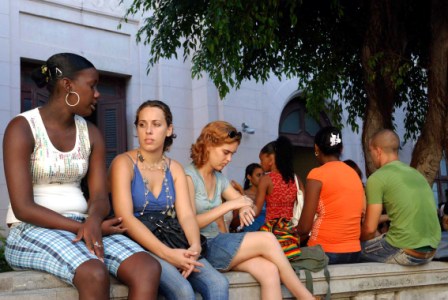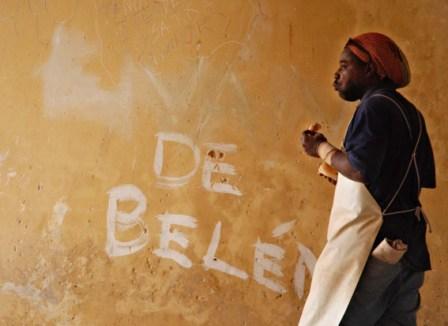Racism in Cuba: An Unresolved Issue
Patricia Grogg

HAVANA TIMES, January 14 (IPS) – Racism is an unresolved issue in Cuban society. “It’s necessary to admit that the problem exists, to know its impact on the social system we defend, and to attack it at its roots,” said Esteban Morales, an economist, political scientist and author of articles and essays on the subject, interviewed by IPS.
As a researcher at the University of Havana’s Center for Hemispheric and US Studies, Morales understands Cuba and the US with equal depth. He responded to the fact that 60 [African-American] intellectuals —some of recognized stature and prestige— accused the Raul Castro government of persecuting and harassing people due to the color of their skin.
Morales believes those accusations “ignore” the reality of his country and “are being mounted as part of the same campaigns that (US) administrations have historically launched against the Cuban Revolution.”
“We speak of racism and say that it’s necessary to improve civil rights, democratic rights, but not only of blacks, but of the entire society. In that struggle we have allies at the highest levels of the country’s political leadership,” he affirmed.
IPS: In what respects did the social efforts of the Cuban Revolution fail by being unable to eliminate the disadvantages of its black population?
ESTEBAN MORALES: Despite the radical nature of the process that opened up in 1959, social programs —for years— did not take color into account. With the triumph of the Revolution, social policies treated all poor people equally, and no distinction was made with respect to blacks. However, this was something that should have been done, because the color of one’s skin is a strong variable of social differentiation in Cuba.

Whites came here of their own will, as settlers, with life goals that were often realized. Blacks were brought here by force and turned into slaves. These are different points of departure that cannot be forgotten, nor can they be avoided, and their weight is still felt today.
Even when everyone’s level was elevated, and blacks achieved a more favorable position over this past half century, the deep differences didn’t totally disappear. When the “Special Period” came (the crisis of the 1990s), we realized that those who suffered most from the crisis were in fact blacks.
Still, in today’s Cuba, it’s not the same to be poor and white as to be poor and black.
IPS: Nevertheless, in 1962 the Cuban government declared that the problem of racism had been resolved.
EM: That was an error of idealism and voluntarism made under the pressure of the political circumstances of the time. Starting from that moment, there began a long period of silence around the issue. This was justified by saying that to talk about those differences was to play into the enemy’s hands. Those who insisted [on the existence of racism] were considered racist and divisive.
The issue resurged with force during the Special Period; I would say with a virulence all its own, which is characteristic of something that is assumed to be resolved but really isn’t.
IPS: On more than one occasion it’s been said that people in this country are educated “to be white.” Do you believe it’s fair to consider these types of contradictions to be forms of “institutionalized” racism?
EM: It’s a certain form of institutionalization, but not through some directive or done in a conscious manner, but a form derived from flaws and errors in the educational process, in the teaching of history, in racial representativeness in our books. By not dealing with the root of the problem in schools, the consequences of slavery persist until today.

These problems do not have to do with institutions, but with aspects and problems of social life, with the dysfunctions and imperfections of our society. Racial consciousness is still lacking in Cuba. For whites this is not important, because they were always in power; but blacks must have a racial consciousness to struggle against racism and for their place in society.
Racial discrimination is a phenomenon that remains on people’s mind, in their families, in personal relationships, and occasionally in some institutionalized groups – which is not easily resolved.
IPS: What is your proposal for solving these deficiencies in education?
EM: The only way to solve this is through the strict monitoring of equal opportunities for all jobs, especially in the new economy, that’s to say in tourism and joint-venture companies involving foreign capital; in education and intensive cultural work.
In fact, we shouldn’t educate for any particular color, but what’s happening in practice is that our students are generally educated thinking that it’s better to be white, and that it’s a disadvantage to be black.
We have to solve problems of occidentalismo (Euro-centrism) in our education, to deepen the teaching of history —about Africa, Asia, the Middle East— and the racial representativeness of our bibliography. We should take the discussion about racial discrimination into schools so that when a young person goes out on the street and hears a racist epithet, they’re able to defend themself against it.
IPS: What do you propose in social terms?
EM: “We are all the same” was also a slogan under Cuba’s demagogic Republican (pre-Revolution) period. Equality is the aim, the goal, as long as inequality and difference are what trip us up daily.

As a starting point, it’s necessary to recognize the inequalities that exist in our society, though we’ve struggled to solve them to a point of verging on egalitarianism. They are an inheritance and, at the same time, a phenomenon that can be reproduced as a result of the dysfunctions of our social model, which must be improved.
Only by understanding these differences in depth and working on them, will we be able to arrive at true equality.
IPS: Do you think it’s necessary to have special programs and policies for the black population?
EM: In Cuba, a certain kind of affirmative action policy exists, though we don’t call it that. Based on the thorough investigation of the situation of the family, the problems of children, people with disabilities, and different social groups, we’re coming up with practices for taking affirmative action, because we’re connecting with people who have been historically less advantaged, those who are more vulnerable.
There is information that needs to be refined, and that can only be done by looking at discrete situations in terms of housing, employment, health care. In everything it’s necessary to keep color in mind, and when the study sample is larger, the more clearly it’s seen that blacks are on the bottom, mestizos are generally in the middle, and whites are on top.
IPS: Why isn’t there a deeper discussion on this matter, covered by the island’s press, so that everyone can recognize it?
EM: The debate is building strength in the intellectual and community environment, as well as in cultural centers, but it also has to reach the agencies of the State, as well as the political, social and mass organizations of the country. That’s what we’re demanding, because according to our studies more than 60 percent of the population of 11.2 million Cubans is non-white (made up of blacks and mestizos).
IPS: Do you believe that it [race] should also be a part of the political agenda?
EM: Of course it should. The fact that President Raul Castro raised the issue in his speech before the parliament on December 20 makes me think the matter could be on the agenda of the upcoming Sixth Congress of the Communist Party of Cuba. If this is not the case, I believe it should be.
In addition, there exist two commissions that are studying the problem from different vantage points: one at the National Library and the other within the National Union of Writers and Artists (UNEAC). The Parliament should also have a commission to look into this matter.
If the legislature deals with the issues of religion, women, and youth, why doesn’t it look at the race issue, which I consider as being at the same level – but which has been the least addressed?
IPS: Is there a risk that the debate be interrupted for fear that it could create internal division, or that it could be manipulated against the Revolution?
EM: To the contrary, what’s actually being used in the campaigns of the enemy is our delay in having addressed the issue of race. What can divide us is our failing to discuss it.
What affects us politically from the point of view of our international and national image is to have a discourse that doesn’t correspond to reality, because until very recently we said there were no racial problems in Cuba.
A Havana Times translation of the original article published in Spanish by IPS

Another excellent article from Havana Times. The only point I wish to make is the adoption of the U.S. discourse when dealing with the internal problems of Cuba, which is not surprising considering the discourse in the U.S. has been in many ways more open over the past 50 years. Any attempt to equate “White” U.S. Americans with “White” Cubans must be fiercely resisted. There is an old Rasta reasoning that states something to the effect that “Blacks” everywhere will not be free until Africa is free. As I have stated in other posts, with U.S. Americans consuming on average five times their fair share of the world’s resources, African freedom remains impossible. As a result of the Revolution, even the lightest skinned Cubans do not consume more than their fair share, and thus do not deprive Africa, even if they might want to. Until the comsumption rate of the U.S. reduces, no “White” American has the right to accuse “Hispanic Cubans” of racism.
I agree 100% with Mr. Morales. I knew this problem had not been addressed by the leadership in Cuba after viewing movies made in Cuba and also the few interactions I have had with Cuban immigrants in the USA.